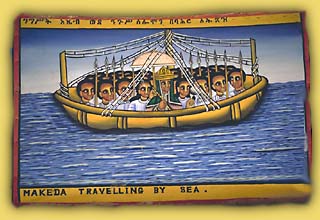|
Palaces, catacombs and obelisks
Our work began the moment that we arrived. Waiting to greet us as we
stepped down from the plane was an elderly Abyssinian gentleman wearing a
slightly threadbare three-piece suit and a most splendid patriarchal beard.
In quaint but excellent English, he introduced himself as Berhane Meskel
Zelelew and explained that he had been contacted by radio from Addis Ababa
and ordered to guide us and act as our interpreter. He was employed, he said,
by the Ministry of Culture 'to keep an eye on the antiquities of Axum'. In
this capacity he had helped the archaeologists from the British Institute in
Eastern Africa whose excavations of some of the city's most interesting ruins
had been interrupted by the revolution of 1974. (14) 'It's so nice to see
other British people here after such a long time,' he exclaimed as we
introduced ourselves.
We climbed into a vintage Land Rover with a lime-green paint job and two
neat bullet holes in the front windscreen. 'Fortunately no one was killed,'
Zelelew reassured us when we asked him about these. Laughing nervously as we
drove away from the airfield, I then explained what we had come to do, listed
the historic sites that we wanted to visit, and told him that I was
particularly intrigued by Axum's claim to be the last resting place of the
Ark of the Covenant.
Do you believe that the Ark is here?' I asked.
'Yes. Certainly.'
'And where is it exactly?'
'It is deposited in a chapel near the centre of the city.'
'Is this chapel very old?'
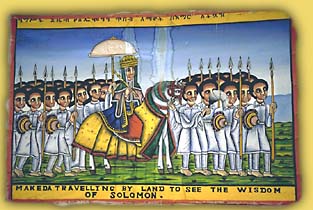
"Makeda travelling by land to see the wisdom of Solomon"
'No. Its construction was ordered by our late Emperor... in 1965 I think.
Before that the relic had rested for many hundreds of years within the Holy
of Holies of the nearby church of Saint Mary of Zion...' Zelelew paused, then
added: 'Haile Sellassie had a special interest in this matter, by the way...
He was the two hundred and twenty-fifth direct-line descendant of Menelik,
son of the Queen of Sheba and King Solomon. It was Menelik who brought the
Ark of the Covenant to our country...'
I was all for visiting the chapel at once, but Zelelew persuaded me that
there was little point in hurrying: 'you will not be allowed anywhere near
the Ark. Where it rests is holy ground. The monks and the citizens of Axum
protect it and they would not hesitate to kill anyone who tried to break in.
Just one man is allowed to enter and he is the monk responsible for guarding
the Ark. We will try to meet him later today, but first let us go and see the
Queen of Sheba's palace.'
After we had assented to this attractive proposition we turned on to a
bumpy, potholed road that - had we been able to follow it all the way - would
eventually have led us hundreds of miles south-west, through the gigantic
peaks and valleys of the Simien mountains, to the city of Gondar near Lake
Tana. In open country barely a mile from the centre of Axum, however, we
stopped within sight of an extensively fortified military post which, Zelelew
explained, marked the limit of the government controlled sector. He waved
expressively at the nearby hills: 'Everything else TPLF, so we cannot go.
It's a pity. There are so many interesting things to see . . . There, just
around that corner in the road, are the granite quarries where all the stelae
were cut. One still remains partially unexcavated from the rock. And there is
a beautiful carving of a lioness. It is very ancient. It was put there before
the coming of Christianity. But unfortunately we cannot reach it.' '
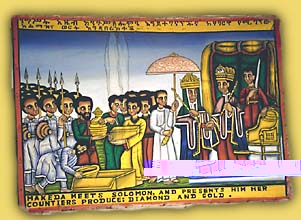
"Makeda meets Solomon and presents him...
How far is it exactly?' I asked, tantalized.
'Very close, less than three kilometres. But the military will not let us
past the checkpoint and if they did we would certainly be taken by the
guerillas. Even here we should not stand around for too long. Your foreign
faces will be noticed by the TPLF snipers. They might think you are Russians
and decide to shoot at you...' He laughed: 'That would be highly undesirable,
would it not? Come, follow me.'
He led the way into fields to the north of the road and we quickly began
to stumble across the remains of what must, once, have been an imposing
building. 'This was the Queen of Sheba's palace,' Zelelew announced proudly.
'According to our traditions her name was Makeda and Axum was her capital. I
know that foreigners do not accept that she was an Ethiopian at all.
Nevertheless no other country has a stronger claim than ours.'
I asked whether any archaeology had ever been done on the site to test the
legends.
'Yes, in the late 1960s the Ethiopian Institute of Archaeology conducted
some excavations here... I helped on the dig.'
'And what was discovered?'
Zelelew made a mournful face. 'The opinion was that the palace was not
sufficiently old to have been the residence of the Queen of Sheba.'
What the archaeologists had unearthed, and what we now spent some time
exploring, were the ruins of a great and well built edifice with finely
mortared stone walls, deep foundations and an impressive drainage system. We
saw a still-intact flagstone floor - which Zelelew claimed was a large throne
room - and a number of stair-wells which hinted at the existence of at least
one upper storey. There were also private bathing areas of sophisticated
design and a well-preserved kitchen dominated by two brick ovens.
Across the road, in a field facing the palace, we then inspected a number
of rough-hewn granite stelae, some standing more than fifteen feet high, some
fallen and broken. Most were undecorated but one, the largest, was carved
with four horizontal bands, each band topped by a row of circles in relief -
like protruding beam ends in a building made of wood and stone. This crude
obelisk Zelelew told us, was thought by the townspeople to mark the grave of
the Queen of Sheba. No excavation work had been carried out beneath it,
however, and the field was now entirely given over to farmers who grew crops
for the Axum garrison. Even as we talked we saw two peasant boys approach
with an ox, which they harnessed to a wooden plough. Oblivious to the history
that lay all around them, and apparently indifferent to our presence as well,
they began to till the soil.
After we had finished taking pictures and notes we drove back into the
centre of the city and then out again to the north-east to another palace
complex, this one on a hill-top with commanding views of the whole area.
Square in plan, the structure measured about two hundred feet on each side.
The walls, which had long since crumbled, showed signs of having originally
been projected at the corners to form four towers - possibly the very towers
which, in the sixth century, the monk Cosmas had described as being adorned
with brass unicorns.
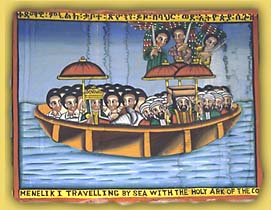
"Menelik travelling by sea with the Holy Ark of the Covenant"
Beneath the fortress Zelelew then led us down steep stone stairways into a
number of underground galleries and chambers which were roofed and walled
with massive dressed granite blocks that fitted precisely against one another
without any mortar in the joints. Local tradition, he said, identified this
cool dark warren as the treasury used by Emperor Kaleb (AD 514-542) and also
by his son Gebre-Maskal. With the aid of a flashlight we saw the empty stone
coffers which lay within coffers believed to have once contained great riches
in gold and pearls.(15) Further rooms, as yet
unexcavated, extended into the
hillside from there, blocked off behind thick granite walls.
Eventually we left the hill-top fortress and made our way down into the
centre of Axum on a gravel road. Near the bottom of the gradient, to our
left, we paused to photograph a large, open deep-water reservoir dug down
into the red granite of the hillside and approached by means of rough-hewn
stairways. Known as the Mai Shum, it seemed to us very old - an impression
that Zelelew confirmed when he remarked that it was originally the Queen of
Sheba's pleasure bath: 'At least so our people believe. Since the beginning
of Christian times it has been used for baptismal ceremonies to celebrate the
Holy Epiphany, which we call Timkat. And of course the peasants still
come here every day to draw their water.' As though to confirm this last
observation he pointed to a group of women carefully descending the time-worn
steps bearing gourds on their heads.
By now, without any of us really noticing how the time had passed, it was
already well past the middle of the afternoon. Zelelew urged us to hurry,
pointing out that we were scheduled to fly back to Asmara at first light the
next day and that we still had much to see.
Our next destination was close by, the so-called 'Park of the Stelae' -
certainly the focal point of Axum's archaeological interest. Here we examined
and photographed a remarkable series of giant obelisks carved from slabs of
solid granite. The most massive of these, a tumbled fractured ruin, was
believed to have fallen to the ground more than a thousand years previously.
In its heyday, though, it had stood one hundred and ten feet tall and must
have dominated the entire area. I remembered from the reading I had done on
the flight that its weight was estimated to exceed five hundred tons. It was
thought to be the largest single piece of stone ever successfully quarried
and erected in the ancient world.
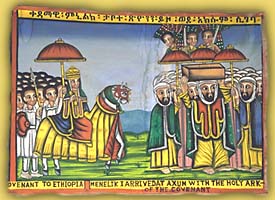
"Menelik arrives at Axum with the Holy Ark of the Convenant"
This fallen stele was painstakingly hewn to mimic a high, slender building
of thirteen storeys - each storey complete with elaborate representations of
windows and other details, and demarcated from the next by a row of symbolic
beam-ends. At the base could be discerned a false door complete with a
knocker and lock, all perfectly carved in stone.
Another fallen - but much smaller and unbroken - obelisk, Zelelew told us,
had been stolen during the Italian occupation of 1935-41, transported with
enormous difficulty to Rome by Mussolini, and re-erected near the Arch of
Constantine. Since it, too, was elaborately carved - and therefore of great
artistic value - the Ethiopian government was campaigning for its return. In
the meantime, however, it was fortunate that a third decorated monolith still
remained in situ in the stelae park.
With a flourish our guide now pointed to this towering stone needle, more
than seventy feet high and topped with a curved headpiece shaped like a half-
moon. We strolled over to examine it properly and found that, like its huge
neighbour, it had been carved to resemble a conventional built-up structure -
in this case a nine-storey building in the fashion of a tower-house. Once
again, the main decoration on the front elevation was provided by the
semblance of windows and of beams of timber supposedly inserted horizontally
into the walls. The intervals between each of the floors were defined by rows
of symbolic log-ends, and the house-like appearance was further enhanced by
the presence of a false door.
Several other stelae of varying sizes were ranged around this refined
monument - all of them clearly the products of an advanced, well organized
and prosperous culture. Nowhere else in sub-Saharan Africa had anything even
remotely similar been built and, for this reason, Axum was a mystery - its
antecedents unknown, the sources of its inspiration unremembered.

Return to Ethiopia Index
Initiation: 1986 |
A great mystery of the Bible |
1983: a country at war
Into Axum |
Palaces, catacombs and obelisks |
The sanctuary chapel
|
|


